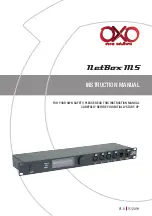
8
RS-232
↔
485/422 CONVERTERS
2. Introduction
The RS-232
↔
485/422 Converter Plus is an RS-232-to-RS-485 interface converter
that operates in the same manner as a line driver. It allows an RS-232 device to
transmit data over much longer distances than is normally possible (up to
4 miles—6.4 km—at 1200 bps). The advantage of the RS-232
↔
485/422 Converter
Plus over other line drivers is that it can also operate in multipoint applications.
Depending on the operating environment, as many as 64 devices can be linked
together using twisted-pair cable.
The opto-isolating models (IC109A, IC109AE, IC109C) protect one segment of
your extended network from problems that arise on the other. Inside the
RS-232
↔
485/422 Opto-Isolator/Converter, optical isolation circuitry converts
electrical signals to light and back again, to keep signal noise and ground loops
from crossing between segments of your RS-485 installation. That means the
electrical noise from your factory floor won’t affect your office communications,
and the difference in ground potential between buildings won’t damage your
sensitive equipment.
Additional features include a manual loopback test to check the system wiring for
both the RS-232 and RS-485 interfaces, and transient protection on the RS-485
interface to help prevent damage due to voltage transients on the data line.
Although designed specifically to connect to other RS-232
↔
485/422 Converters,
the RS-485 port may be connected to any device with an RS-422 or RS-485
interface, thus acting as an interface converter. For example, this would be useful
in an industrial application where RS-485 or RS-422 devices would be connected to
an RS-232
↔
485/422 Converter.
The RS-232
↔
485/422 Converter is available in standalone and rackmount
versions. The rackmount cards (part numbers IC108C and IC109C) are designed
to be installed in the multi-function rack (part number RM005).
If you ordered the IC109A-R2, you should have received a cable and an adapter
with your RS-232
↔
485/422 Converter Plus. The cable is designed to plug into an
IBM PC AT (or clone) DB9 com port. The adapter is designed to be used with the
supplied cable to connect to an IBM PC computer’s DB25 com port.










































